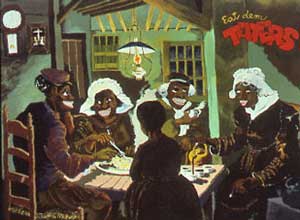Review/Art; Turbulent Restatements From Robert Colescott
BY: JOHN RUSSELL
EXCERPT:
A necessary museum show is ”Robert Colescott: A Retrospective, 1975-1986,” which has just arrived at the New Museum of Contemporary Art.
Organized by the San Jose Museum of Art in California in 1987, the show has been seen in seven American cities and will go to the Seattle Art Museum at the end of its showing in New York. More recent paintings from the same turbulent hand can be seen at the Phyllis Kind Gallery.
Robert Colescott is a black artist, born in Oakland, Calif., in 1925, who graduated from the University of California at Berkeley in drawing and painting, went on to study with Fernand Leger in Paris (1949-50) and in the 1960’s spent two years in Cairo, first as artist in residence at the American Research Center and later on the faculty of the American University. Given this background, and given also his combative and articulate intelligence, it must always have seemed likely that he would one day work from a backlog of curious and potentially explosive images. (Even the Valley of the Queens at Thebes was eventually put to work for him.) As of 1975, with ”Eat Dem Taters” – a reworking of van Gogh’s ”Potato Eaters” – he addressed a whole slew of subjects that have occupied him ever since. Though baited with a wild, driving and sometimes apocalyptic humor, the paintings challenge us to cope with serious problems that are overdue for resolution. One of them is the persistence of a stereotyped view that should have been junked many years ago.
The immediate impact of ”Eat Dem Taters” derives from the contrast between the grieving, prayerful and intensely depressive character of van Gogh’s ”Potato Eaters” and the highly energized and apparently gleeful image of a black family sitting down, some time in the last century, to one of the most frugal of all dinners.

Eat Dem Taters, 1975.
”Eat Dem Taters” can impress as a portrait of exhilaration, even if the people portrayed have nothing whatever to be exhilarated about. This critic has never forgotten the tonic excitement of seeing it for the first time.
But this is also a polemical painting, in ways made clear by the artist in the interview on videotape that can be seen at the New Museum. It is, in his own words, ”a frontal, brutal attack on the myth of the happy darky,” with a raw, almost minstrel element in it. It has always been convenient for white people to believe that black people can sing and laugh and be happy, whether or not they have anything decent to eat. It is Mr. Colescott’s achievement that, without for a moment seeming to sermonize, he points out the absurdity and the injustice of that belief.
The bulk of the show dates from the years when Mr. Colescott was reworking paintings by van Eyck, Mantegna, Delacroix, Manet, Picasso, Willem de Kooning and Emanuel Leutze (”Washington Crossing the Delaware”). It is not very difficult to make an arresting image by shifting the emphasis of one that we all know already. If the pregnant bride in van Eyck’s ”Arnolfini Marriage” is black, and if van Eyck’s elegant inscription in the background is replaced by the words ”Natural Rhythms” writ large, the result has a cartoonish look, There is an altogether subtler, deeper and more complex motivation behind the ”George Washington Carver Crossing the Delaware: Page From an American History Textbook” (1975), in which the national hero in Leutze’s famous painting is replaced by the slight, slender, unforgettably brainy figure of Carver, the pioneering agricultural chemist. Five years later, in his reworking of Manet’s ”Dejeuner sur l’Herbe,” Mr. Colescott treats the original with an easy affection while giving a new and pertinent twist to the three principal figures, In the 1980’s, as we can see at the New Museum, Mr. Colescott got altogether freer in his references to Old Master painting. His evocations of a white Venus, fallen among black bathers, are the more telling for not having quite so sharp a point to hammer home. We sense, in fact, that his journey through the history of white men’s art may be nearing its end. Certainly he himself abhors the idea that he simply paints pictures about other people’s pictures. (He particularly dislikes the idea that people began to ”watch for the trick” in every new reworking that came along.) ”Most of my work,” he says, ”is generated by my own ideas.”
Visitors to the Phyllis Kind Gallery will find this borne out. Mr. Colescott today is now very much on his own where images are concerned, and many of them have a diluvian quality, as if he had more ideas than he could cope with. There is no reason to think he will run out of them, either.
”Robert Colescott: A Retrospective, 1975-1986” remains at the New Museum of Contemporary Art, 583 Broadway, near Prince Street, through April 16. Paintings by the artist remain at the Phyllis Kind Gallery, 136 Greene Street, through Thursday. Helen Miranda Wilson Sorkin Gallery 596 Broadway (near Houston Street) Through April 1.
